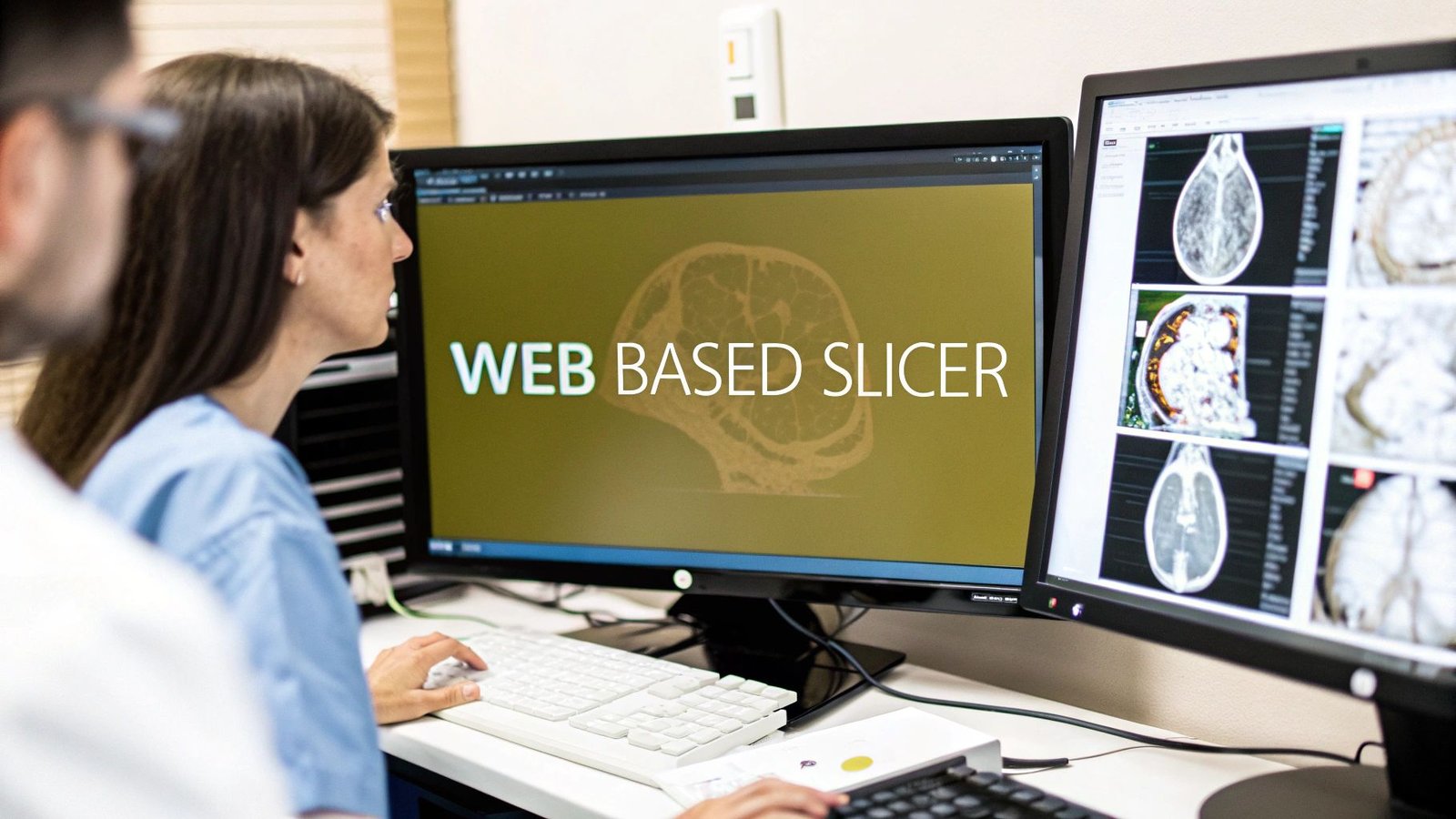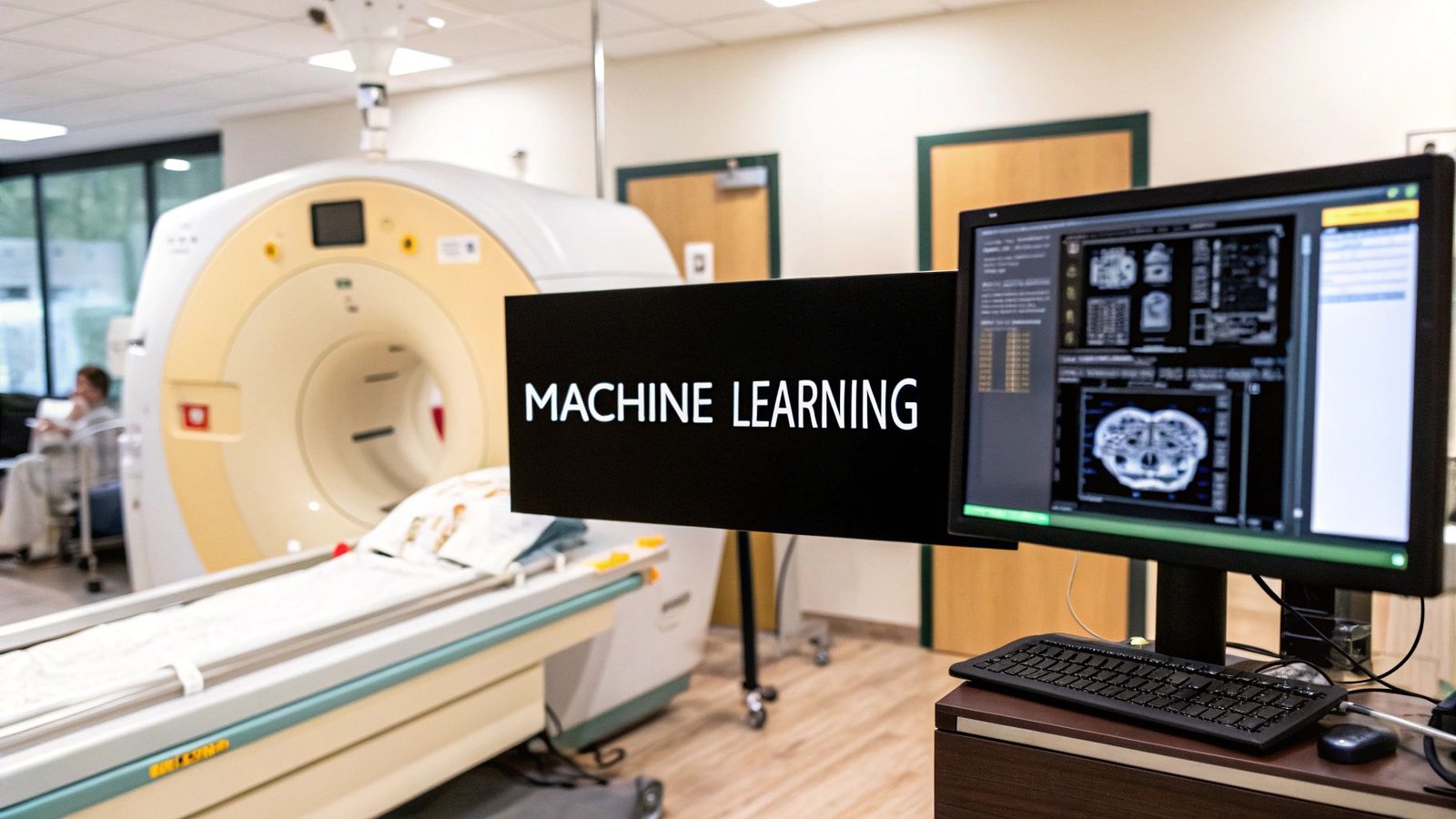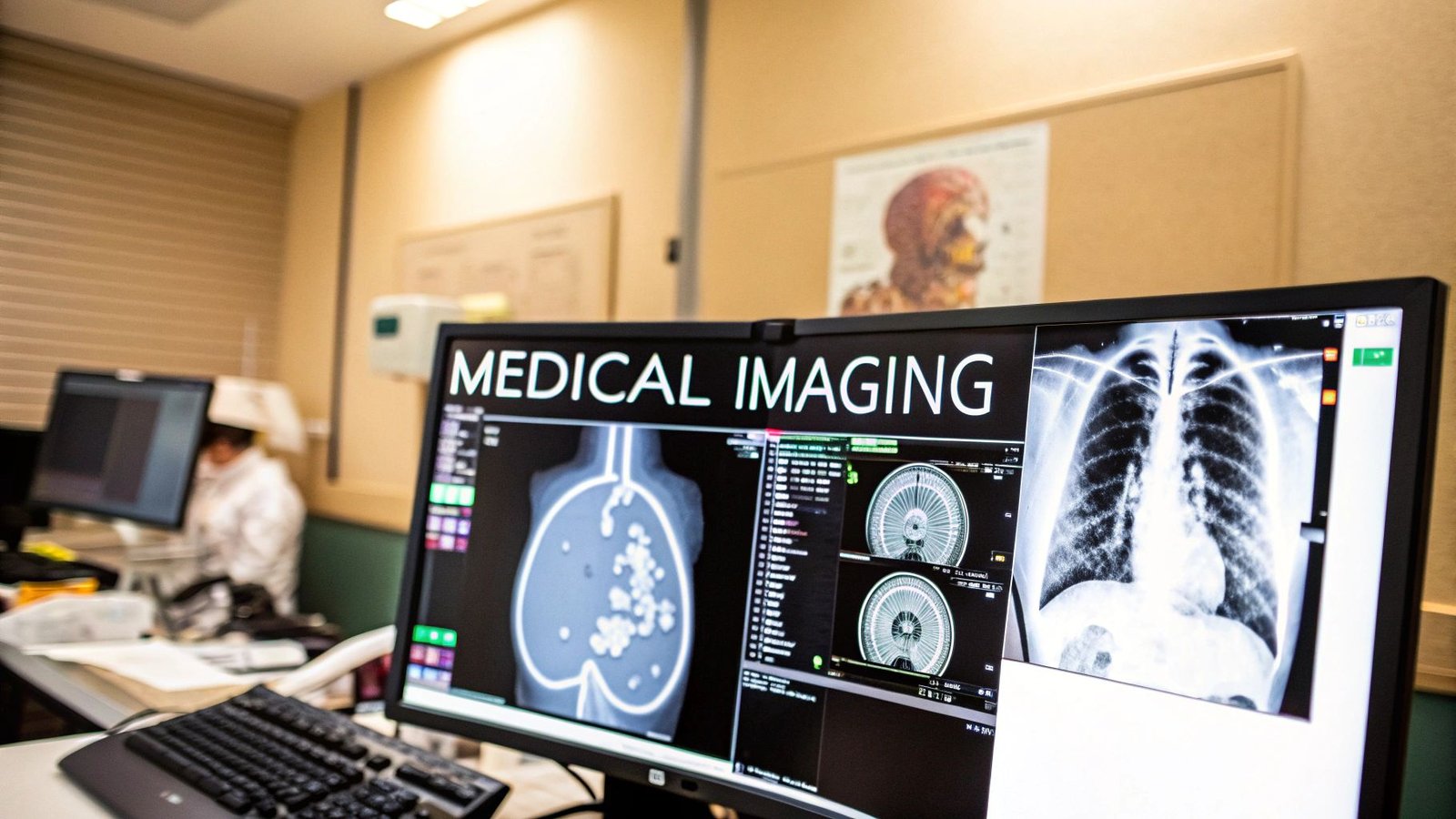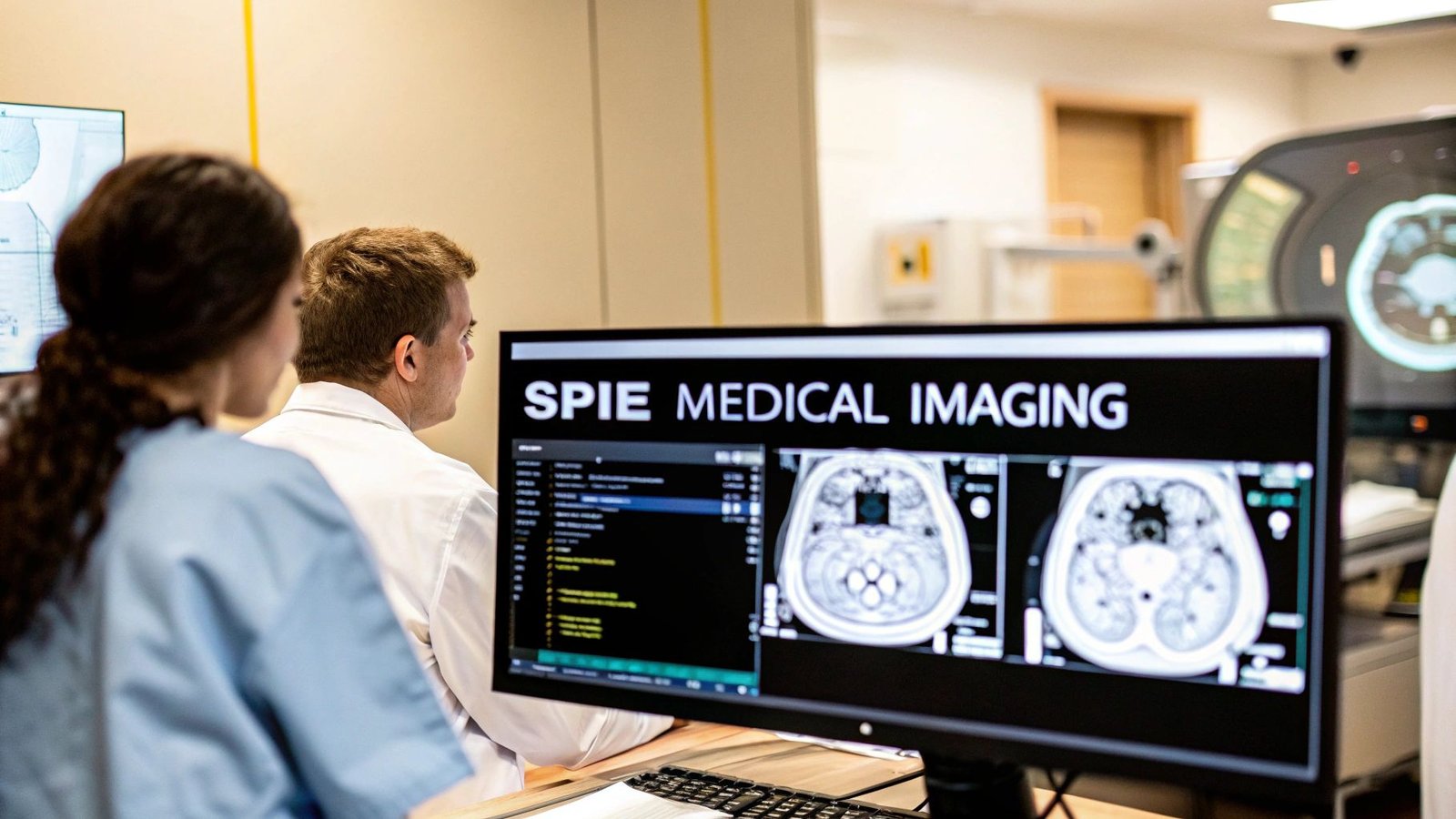For years, wrestling with complex MRI and CT scans meant being chained to a specific, high-powered workstation. That world is quickly becoming a memory. We're now in an era where sophisticated 3D medical image visualization happens right inside your web browser, thanks to the web based slicer.
This isn't just a minor upgrade; it's a technology that completely shatters old barriers, opening up access for doctors, researchers, and even patients in ways we once only imagined. At PYCAD, we build custom web DICOM viewers and integrate them into medical imaging web platforms to drive this transformation.
A New Age for Medical Image Viewing
Think of the old desktop viewers like landline phones—powerful for their time, but completely stationary. A web based slicer is the smartphone that replaced it. It's accessible everywhere, surprisingly powerful, and always connected. This leap means any device with a browser can transform into a high-end medical imaging station.
This shift from clunky, locally-installed software to nimble, browser-based platforms is a massive step forward. It directly tackles the headaches that have slowed down workflows for decades: hardware dependency, frustrating software installations, and the near-impossibility of secure remote access. Integrating these advanced visualization tools is pushing healthcare forward, much like how immersive technologies such as medical training VR are redefining how medical professionals learn.
The Power of Anytime, Anywhere Access
The most profound impact of a web based slicer is how it demolishes physical and technical walls. A clinician is no longer tethered to a single computer in the radiology department. They can review a critical scan, plan a complex surgery, or consult with a colleague from their office, their home, or even from across the globe.
This level of access has immediate, life-changing implications for patient care:
- Faster Diagnoses: A specialist can weigh in on an urgent case in minutes, not hours, without needing to be physically present.
- Smarter Collaboration: Surgeons, radiologists, and referring physicians can all look at and manipulate the exact same 3D model together in real-time. This leads to more comprehensive, better-informed decisions.
- Expanded Teleradiology: Experts can now serve remote or underserved communities that don't have local specialists, helping to close critical gaps in healthcare access.
A web based slicer isn't just about looking at pictures on a different screen. It's about making vital medical data interactive, collaborative, and instantly available right when it's needed most—no matter where that is.
Before we dive deeper, let's quickly see how these two approaches stack up against each other.
Desktop vs Web Based Slicer at a Glance
This table offers a quick comparison, highlighting the fundamental differences between traditional, locally installed medical imaging software and modern web based slicers.
| Feature | Traditional Desktop Slicer | Modern Web Based Slicer |
|---|---|---|
| Accessibility | Limited to specific, licensed machines. | Accessible on any device with a web browser. |
| Installation | Requires manual installation and frequent updates. | No installation needed; always runs the latest version. |
| Collaboration | Difficult; involves emailing files or using screen share. | Seamless real-time collaboration with shared views and tools. |
| Data Storage | Stored locally on the machine, creating data silos. | Centralized cloud storage for easy, secure access. |
| Hardware | Demands high-end, powerful workstations. | Works on most devices, as processing is handled by servers. |
| Cost | High upfront costs for software licenses and hardware. | Often a more flexible subscription-based model. |
It's clear that the web-based approach offers a more flexible, scalable, and collaborative future for medical imaging.
At PYCAD, we're building that future today. We build custom web DICOM viewers and integrate them into comprehensive medical imaging web platforms. Our goal is to make these powerful tools intuitive, secure, and a seamless part of the clinical workflow. You can see some of our work in our portfolio.
This technology is more than just a simple update. It’s a complete reimagining of how medical professionals interact with patient data, setting the stage for a more connected, efficient, and ultimately more effective era in medicine.
How a Web Based Slicer Actually Works
Ever wonder what’s going on under the hood of a web based slicer? It's not one single piece of magic, but rather a brilliant symphony of modern web technologies playing in perfect harmony. This is how any standard computer can suddenly feel like a high-powered medical imaging workstation, all without downloading a single piece of software.
At the very heart of this experience is WebGL (Web Graphics Library). The best way to think of WebGL is as the dedicated graphics engine already built right into your browser. It’s the powerhouse that lets you render and interact with complex 3D models smoothly—a job that used to demand specialized, expensive hardware and dedicated desktop programs.
Because this capability is native to the browser, there are no plugins to install or clunky updates to manage. The power to spin, zoom, and slice through intricate anatomical structures is already waiting inside the tools you use every day, whether it's Chrome, Firefox, or Edge.
The Technology That Makes It All Possible
So, how does a simple browser tab manage to handle massive medical imaging files? We're talking about DICOM datasets that can easily run into several gigabytes. The secret is all about intelligent data handling, kind of like how Netflix streams a 4K movie. You don't download the entire film before you start watching; the platform sends you just the bits you need, exactly when you need them.
A web based slicer works the same way. Instead of overwhelming your local machine by trying to download and process the whole dataset at once, it cleverly requests and loads only the specific image slices you’re currently looking at. This "just-in-time" approach is what keeps the experience fluid and responsive, even with incredibly large and complex scans.
This smart data management is often paired with one of two core rendering strategies:
- Client-Side Rendering: Here, your own computer’s browser uses its processing power (thanks to WebGL) to render the 3D model. This is fantastic for smaller datasets and gives you that instant, snappy feeling of direct interaction.
- Server-Side Rendering: With this method, a powerful remote server does all the heavy lifting. It crunches through the massive dataset and streams the finished visuals to your browser. This means even a basic tablet or an older laptop can interact with enormous 3D models without breaking a sweat.
This infographic shows how these pieces fit together, creating a tool that is powerful, accessible, and built for collaboration.
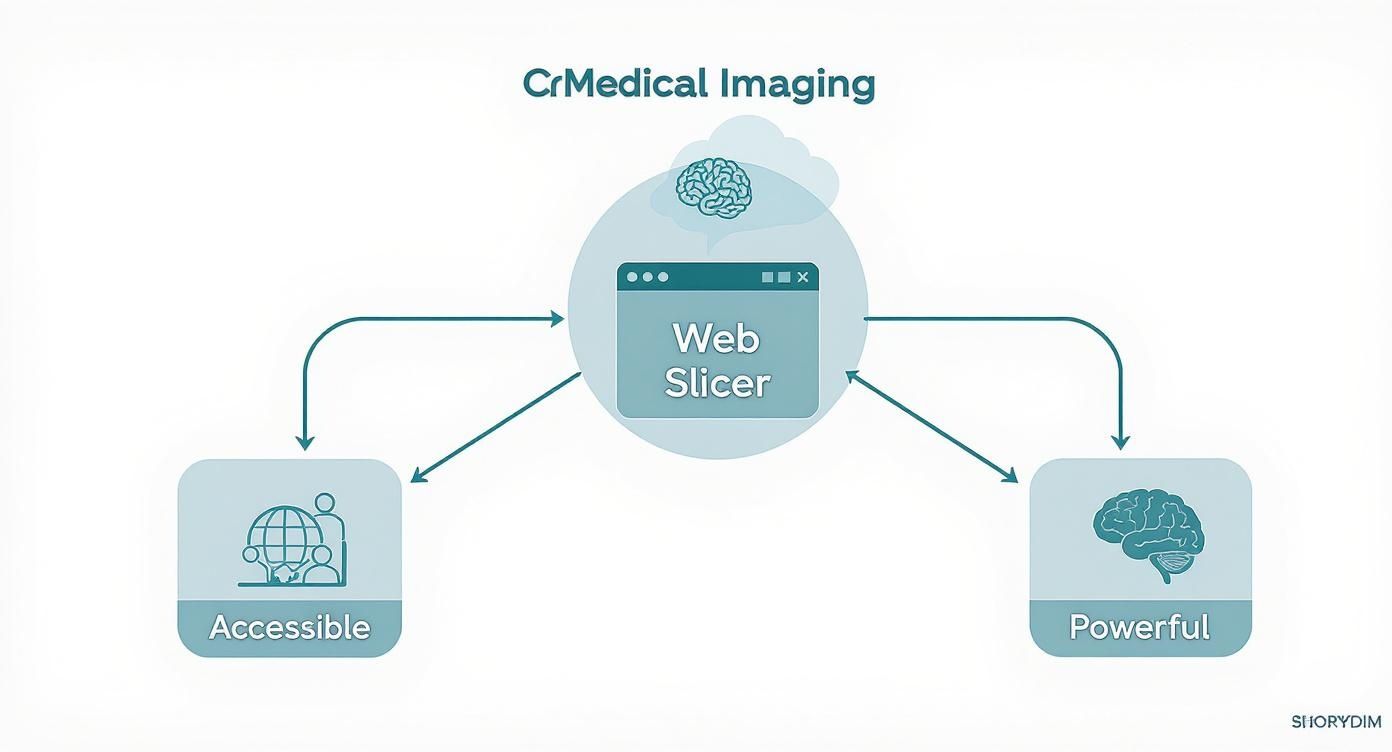
As you can see, the strength of a web slicer comes from a perfect blend of on-demand access, teamwork potential, and the raw computational power working behind the scenes.
Following the Data from Server to Screen
For this whole system to work, the slicer needs a clean line of communication to the source of the medical images—typically a PACS (Picture Archiving and Communication System). This is where standardized protocols are absolutely crucial. Modern web viewers rely on protocols like DICOMweb, a web-friendly standard for accessing and managing medical images. If you're curious about the details, you can learn more about the core DICOM standards that make this seamless connection possible.
The true innovation of a web based slicer isn't just about putting a 3D model in a browser. It’s the entire ecosystem—from efficient data streaming and powerful rendering to standardized communication—that unlocks genuine, unhindered access to medical imaging.
At PYCAD, our expertise is in conducting this technological symphony. We don't just build custom web DICOM viewers; we architect and integrate them into medical imaging web platforms that are as powerful as they are intuitive. We handle the complex backend processes flawlessly so clinicians can have a smooth, reliable experience and focus on what they do best: taking care of patients.
Why Adopting a Web Slicer Is a Game Changer
So, why would a busy hospital, a growing clinic, or a cutting-edge research team even consider making the switch? Moving to a web-based slicer isn't just a minor tech upgrade. It's about fundamentally rewiring your entire workflow for the better—making collaboration seamless, speeding up critical decisions, and ultimately, elevating the quality of patient care.
The first thing you'll notice is the incredible jump in accessibility. We’ve all seen it: the one high-powered workstation in the corner of the reading room that everyone has to queue up for. A web slicer blows that limitation wide open. Suddenly, specialists can securely pull up and analyze complex scans from literally anywhere they have an internet connection. Picture a radiologist giving a critical consult from their home office, or a surgical team in different cities planning a complex procedure together in real-time. That’s not a future concept; that’s what this technology unlocks today.
This freedom naturally sparks a more dynamic and collaborative environment. Instead of emailing static screenshots back and forth, a web platform lets everyone—from surgeons to referring physicians to researchers—look at and manipulate the very same 3D model at the same time. The endless delays and potential for miscommunication just melt away, paving the path for faster, more confident decisions.
Driving Efficiency and Slashing Costs
Beyond the obvious clinical wins, bringing a web slicer into the fold makes a world of sense from an operational and financial standpoint. Traditional desktop viewers are expensive. You have the hefty software licenses for every single machine, not to mention the powerful, specialized hardware needed just to run them. A web-based approach completely flips that model on its head.
By letting a central server do all the heavy computational work, you no longer need a fleet of expensive workstations. This shift delivers some powerful advantages:
- Dramatically Lower Hardware Costs: Your team can work effectively on standard-issue computers, laptops, or even tablets. The days of needing a souped-up PC on every desk are over.
- Simplified IT Headaches: Forget updating hundreds of individual machines one by one. Software updates happen once, on the server. That’s countless hours of manual IT labor given back to your team.
- Smarter Licensing: Many web solutions run on flexible subscription models, freeing you from rigid and costly per-seat licenses.
It’s not just about saving money; it’s about simplifying your entire IT infrastructure. Instead of managing a scattered collection of high-maintenance machines, your IT department can focus its energy on maintaining one secure, centralized system.
Centralizing Data and Fortifying Security
In healthcare, data security isn't just important—it's everything. A web-based slicer is, by its very nature, a more secure way to handle sensitive information. With old-school desktop software, patient data is often downloaded and stored locally on dozens of different computers, creating a minefield of potential security risks.
A web platform keeps the data where it belongs: on one secure, central server. The viewer is simply a window to that data; the massive DICOM files are never fully downloaded to the local device. This centralized control is a massive leap forward for security and compliance.
By preventing patient data from being copied onto countless local machines, a web-based slicer drastically shrinks the attack surface. It inherently minimizes the risk of a data breach and makes it far easier to maintain control over sensitive information.
This shift isn't happening in a vacuum. The global slicing software market was valued at around $907 million in 2024 and is on track to rocket past $3 billion by 2032, largely fueled by exactly these kinds of advancements in healthcare. You can explore more about this market expansion and see how cloud platforms are at the heart of this growth.
At PYCAD, we don’t just talk about these benefits—we build them. We build custom web DICOM viewers and integrate them into secure, powerful medical imaging platforms. Our goal is to help your organization unlock this new level of accessibility, efficiency, and security. See how we've helped others do just that by checking out our portfolio.
Bringing Your Vision to Reality
Making the leap to a web-based slicer isn't just a technical upgrade; it's a strategic move that can fundamentally change how your clinical teams work together. But turning that exciting idea into a functional, day-to-day tool requires a clear and practical roadmap. It’s a journey that starts with defining your clinical needs, taking a hard look at your current infrastructure, and carefully navigating the non-negotiable world of data security and compliance, especially HIPAA.
The first step is always introspection. What specific problem are you trying to solve? Maybe you want to speed up diagnoses by letting specialists consult on cases from anywhere in the world. Or perhaps your goal is to get surgical teams on the same page by giving them a shared 3D space to plan complex procedures. Pinpointing these objectives is absolutely critical—they will be the compass that guides every single decision you make from here on out.
Once you know why you're doing this, you have to assess your existing technical environment. A successful rollout has to feel like it belongs, working with your current systems, not against them. This means ensuring it can talk seamlessly to your Picture Archiving and Communication System (PACS) and Electronic Medical Record (EMR) platforms. The right web-based slicer should feel like a natural extension of your workflow, not some clunky, disruptive add-on.

Choosing Your Implementation Path
With a clear vision and a good handle on your infrastructure, you’ll arrive at a major fork in the road: do you go with an off-the-shelf product or partner with experts to build a custom solution from the ground up? Each path has its own advantages, and the right answer depends entirely on your unique situation.
- Off-the-Shelf Solutions: These are a fantastic way to get up and running quickly and often more affordably. They come with a standard set of features that can meet the general needs of many organizations right out of the box.
- Custom-Built Solutions: This route delivers a platform perfectly tailored to your specific clinical processes, user needs, and integration points. It offers unmatched flexibility and can become a true competitive advantage for your practice.
This decision is often where bringing in seasoned specialists really pays off. At PYCAD, we don't just build software; we build solutions. We build custom web DICOM viewers and expertly integrate them into existing medical imaging web platforms. Our entire approach is designed to make sure the final product enhances your clinical processes, rather than forcing your team to adapt to a rigid, one-size-fits-all system.
Navigating the Technical and Regulatory Landscape
The rise of browser-based tools is impossible to ignore, and it’s happening far beyond medical imaging. Just look at the 3D printing world, where the market for slicer software is absolutely exploding. The global 3D printing slicer software market was valued at around $2.4 billion in 2024 and is projected to hit $3.07 billion in 2025—that's a staggering compound annual growth rate of 27.7%.
This rapid growth brings incredible opportunities, but in healthcare, it also brings immense responsibility. Security and compliance can't be an afterthought; they have to be the bedrock of your entire implementation.
A well-architected web-based slicer actually strengthens your security posture. By centralizing data on a secure server and only streaming pixels to the browser, you eliminate the risky practice of downloading sensitive patient files onto countless local devices. This alone dramatically reduces the risk of a data breach.
Strict adherence to standards like HIPAA is simply not optional. This means putting robust user authentication, end-to-end data encryption, and detailed audit trails in place to ensure every single interaction is secure and meticulously logged. If you're starting to explore how to put these tools into practice, you might find our guide on using a 3D slicer online helpful, as it touches on some of these key considerations.
In the end, turning your vision into a reality comes down to making smart, informed choices that align with your long-term goals. Whether you choose a ready-made viewer or a bespoke platform, the key is to land on a solution that truly empowers your clinicians, simplifies life for your IT department, and ultimately elevates the quality of patient care.
Web Slicer Technology in Action
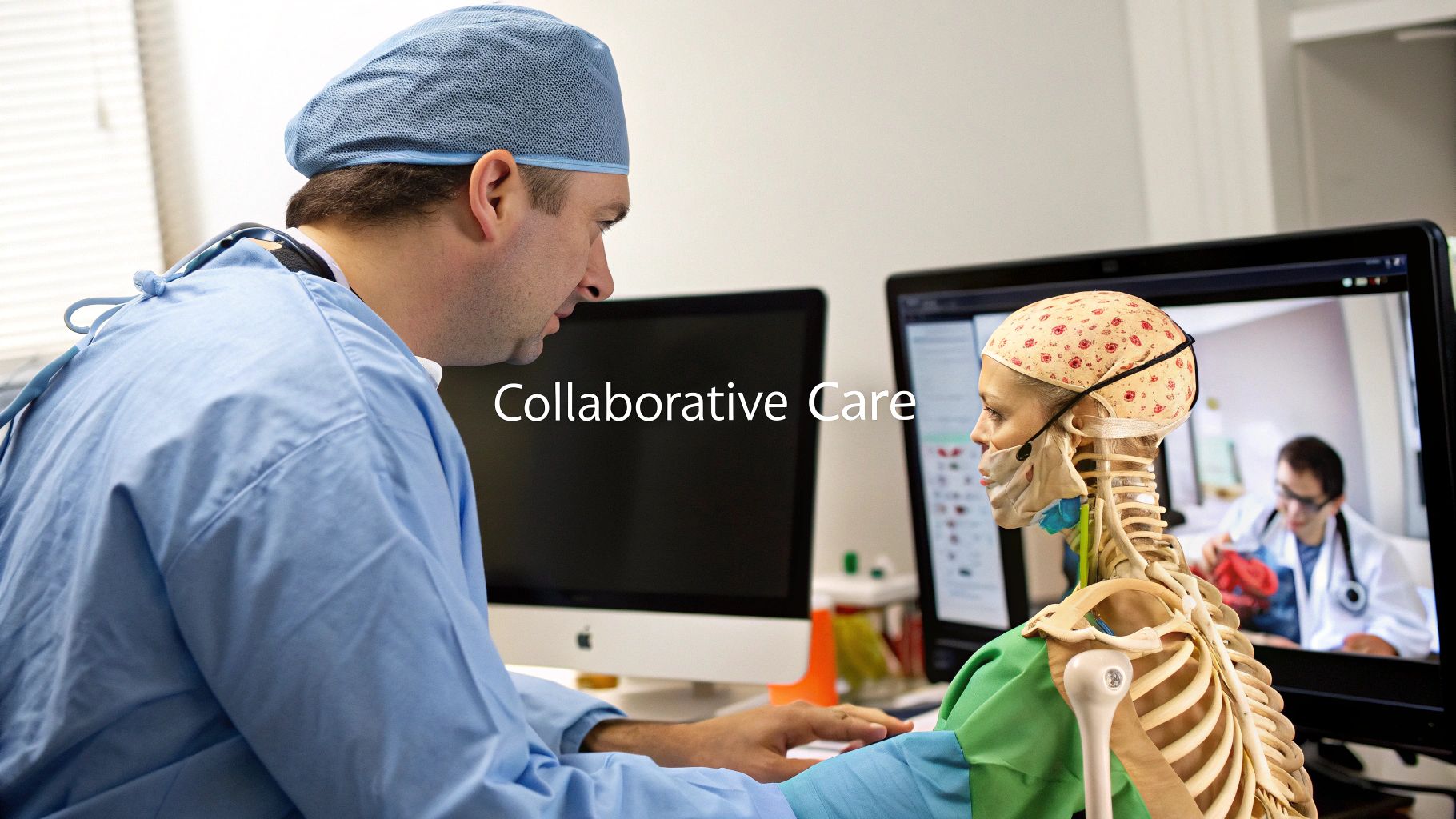
It’s time to move beyond the technical specs and see what a web based slicer truly looks like in the real world. This isn't some far-off concept from a sci-fi movie; it's a practical tool that’s already changing lives by turning complex scan data into clear, actionable insights for clinicians.
Think of each application as a story—a story of how making 3D imaging interactive and accessible leads to better patient outcomes. From major metropolitan hospitals to small clinics in the countryside, these tools are weaving a more connected, efficient, and human-centered healthcare system.
A New Era for Teleradiology and Remote Care
One of the most profound applications is in teleradiology. A web based slicer gives radiologists the power to deliver expert diagnoses to patients anywhere, smashing through the geographical barriers that have long created gaps in healthcare. A specialist is no longer tethered to a high-powered workstation in a hospital basement.
Instead, they can securely log in from their office or even from home to review an urgent CT or MRI scan from a rural clinic hundreds of miles away. This is a genuine lifeline for smaller facilities without on-site specialists. A patient gets a top-tier diagnostic read in a fraction of the time, which means treatment can start sooner. It’s a shift from location-based care to a truly global, on-demand resource.
Precision and Collaboration in Surgical Planning
For a surgical team, a web based slicer is like a shared, interactive blueprint for the human body. It creates a virtual space where surgeons, radiologists, and engineers can meet—no matter where they are physically—to walk through a complex procedure step-by-step. They can rotate the patient's anatomy, map out incision paths, and flag potential roadblocks together.
This kind of detailed, interactive rehearsal is proven to shorten time in the operating room, lower risks, and ultimately lead to better surgical outcomes for the patient.
This shared 3D environment builds a deep, unified understanding of the patient’s unique anatomy. When the entire team can explore the challenges together, they walk into the OR with a solid plan and a shared sense of confidence.
This forward-thinking approach is especially critical in delicate fields like neurosurgery or complex orthopedic reconstructions, where absolute precision is everything.
Transforming Medical Education and Patient Conversations
The impact doesn't stop at the operating room door. Web based slicers are completely changing how we train the next generation of doctors and nurses. Medical students can finally break free from flat, static diagrams in a textbook and get their hands on real anatomical data. This kind of interaction builds a far more intuitive and lasting understanding of the human body.
That same visual clarity is a game-changer when talking with patients. A doctor can pull up a simplified 3D model from a web based slicer to visually explain a diagnosis or walk a patient through exactly what a proposed surgery will entail.
- Deeper Understanding: Patients see their own anatomy, which helps them grasp what’s happening inside their bodies.
- Greater Engagement: This visual dialogue creates a partnership, leading to more informed consent and better follow-through on treatment plans.
- Reduced Anxiety: Taking the mystery out of the medical process with clear visuals helps ease patient fears and build a foundation of trust.
Many of these incredible applications are built on open-source projects like the OHIF Viewer. To get a better feel for how these platforms work, you can dive into our comprehensive overview of the OHIF Viewer and see its role in the world of modern medical imaging.
Here at PYCAD, we take these foundational ideas and build solutions that make a real difference. We specialize in developing custom web DICOM viewers and integrating them into clinical platforms, bringing these powerful applications to life. Our focus is on creating tools that are not just technically advanced but also incredibly intuitive, making state-of-the-art visualization a natural part of everyday medical practice.
The Future of Imaging Is in Your Browser
We’re at a fascinating turning point in medical technology. The web based slicer is growing up, shifting from a simple viewing tool into something far more powerful—an intelligent, interactive hub for diagnostics and planning. The future isn't just about seeing scans; it’s about building platforms that work alongside clinicians, help predict outcomes, and deepen our grasp of human anatomy, all from a web browser.
Right around the corner, we're seeing AI and machine learning woven directly into these web platforms. Picture an AI that instantly segments complex organs the moment a scan loads, freeing up a radiologist from hours of painstaking manual effort. This isn't science fiction anymore. It’s the new reality of instant diagnostic support, flagging potential issues and offering initial insights directly within the viewer.
A More Immersive and Intelligent Reality
Beyond AI, the way we physically interact with medical data is about to change completely. Technologies like WebXR are opening the door to truly immersive experiences. Surgical planning can now move beyond a flat screen and become a full-fledged 3D virtual rehearsal. Imagine a surgeon literally "stepping inside" a patient's anatomy, moving organs around in virtual or augmented reality to map out the perfect surgical path before ever making an incision.
Looking forward, the evolution of browser-based imaging will lean heavily on futuristic user interface design to make these powerful interactions feel natural and intuitive. This trend of web-powered intelligence isn't happening in a vacuum. Even in unrelated industries, this push is obvious. Take the household food slicer market, for example, which is valued between $390 million and $410 million in 2024. It's growing thanks to smart appliances with digital interfaces, proving how web integration brings value to almost everything.
The big idea here is simple: the web browser is becoming the definitive platform for healthcare innovation. It's the most accessible, scalable, and potent environment we have for launching the next wave of medical tools.
Putting resources into these web-based solutions isn’t just about updating your current setup. It’s about preparing your organization for a future where medicine is more intelligent, collaborative, and deeply connected than ever before.
At PYCAD, our mission is to build this future. We build custom web DICOM viewers and integrate them into medical imaging platforms designed to meet tomorrow's challenges head-on. To see how we're already bringing these forward-thinking solutions to life, we invite you to take a look at our portfolio.
Answering Your Questions
Stepping into the world of web-based slicers always sparks a few questions. It’s a big shift, after all. Let’s walk through some of the most common ones I hear from clinics and developers, so you can feel confident about bringing this technology into your workflow.
Is Patient Data Truly Secure on a Web-Based Slicer?
This is, without a doubt, the most critical question—and the answer is a resounding yes. Security isn't just a feature; it's the foundation these systems are built on. Think of it like a digital fortress, protected by layers of end-to-end encryption, hardened server security, and strict access controls.
By keeping the data centralized, a web-based slicer actually tightens your security. It prevents the all-too-common problem of patient scans ending up on various personal laptops or unsecured drives, giving you a single, controllable point of access.
Do We Need to Buy High-End Computers to Run This?
That's the beauty of it—absolutely not. One of the biggest wins of a web-based slicer is that it democratizes access to powerful imaging tools. All the heavy lifting, the intense computational work of rendering a 3D model from a scan, happens on a powerful remote server.
This means your clinicians can view and manipulate complex models on just about any device they have—a standard-issue laptop, a tablet, or even their smartphone. No more waiting for a specific, souped-up workstation to become available.
Will a Web-Based Slicer Work with Our Existing PACS?
Of course. Modern web viewers and slicers are designed to play nicely with the systems you already rely on. They use universal standards like DICOMweb and flexible APIs to plug right into your existing Picture Archiving and Communication Systems (PACS) and Electronic Medical Record (EMR) platforms.
The goal isn't to rip and replace your current infrastructure. It's to build a powerful, accessible bridge that connects your data to your team, no matter where they are.
This kind of seamless connectivity is exactly what we're passionate about building.
At PYCAD, we don't just talk about these ideas—we bring them to life. We specialize in crafting custom web DICOM viewers and integrating them into secure, intuitive medical imaging platforms.
You can see this philosophy in action by exploring some of our work at https://pycad.co/portfolio.
